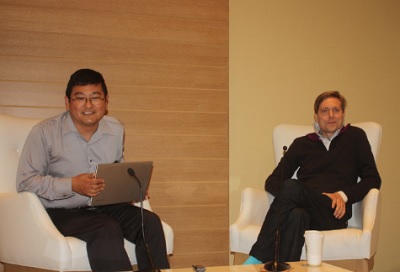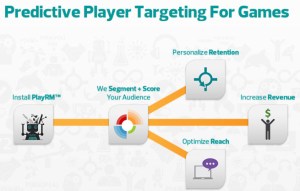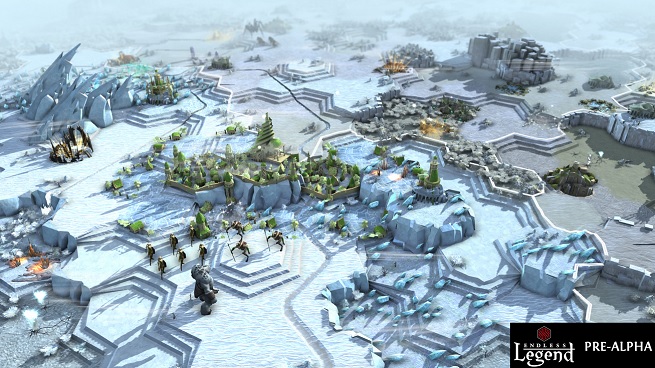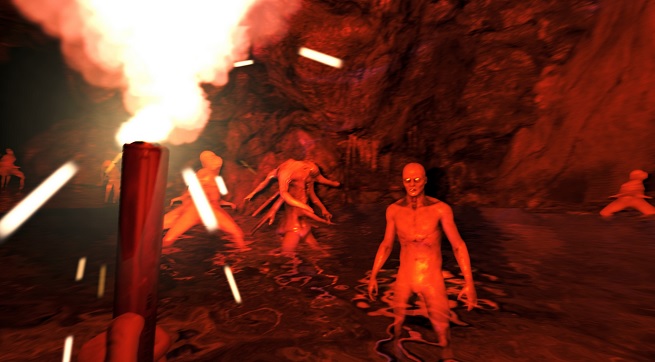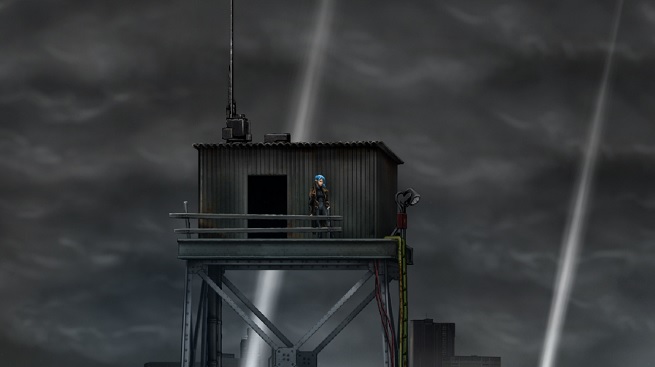David Helgason has grown up with indie-game developers by providing tools like the Unity 5 engine for building cross-platform games. As mobile exploded, so did Unity, which can be used to publish games across Android, iOS, PC, Facebook, the web, and next-generation consoles.
But Helgason, the chief executive of Unity Technologies, doesn’t like to see game developers die. So the San Francisco-based company has expanded into providing services for game discovery, predictive analytics, and monetization. And it has a growing asset store, where game developers can sell their own tools and art components for others to use in their games. The idea is to equip developers for survival in a world where there are a million competitors. At the same time, Unity is beefing up the quality of its 3D animation tools so that it can compete with high-end rivals Unreal and Crytek. That’s going to make mobile games look much better — World of Warcraft publisher Blizzard used Unity to bring its popular and successful card battler Hearthstone to iPad — and hopefully broaden the selection of games in the $16 billion mobile game business.
I interviewed Helgason onstage at the Mobile Gaming USA event in San Francisco this week. Here’s an edited transcript of our talk.
GamesBeat: You started in 2004. For our crowd here, why don’t you bring us up to date on how large Unity has become?
David Helgason: Sure. Actually, code was written as early as 2001 and 2002. But we formed the company in 2004, when I had been part of a group for about a year. We launched Unity 1.0, our game engine and development platform—originally it wasn’t for mobile games, because mobile was kind of shitty back in 2005. I was going to say it didn’t exist, but that’s not true. In fact, I’d worked for Nokia before this.
But we launched as a Mac/PC/web development platform, and then when iOS opened up in 2008, we were bizarrely enough not just first there, but we were by far the first. Nobody else was doing tools for iOS development until, as far as I can tell, 2010 or something? Which is why when Android came out with the native SDK, we went there as the first development platform as well.
We’re not originally a mobile platform, but we wrote that very fast. It’s benefited the ecosystem, obviously, as we well know. It’s grown at some ridiculous, historically very rare rates. We’ve been able to follow that.
There are all kinds of ways to measure our business. We have a tool that can develop for pretty much every platform that matters, and some that don’t matter to everyone. In the last month, 630,000 developers used our platform to develop for something like 9 million hours.
GamesBeat: It was something like 300,000 in 2012, right?
Helgason: Yeah. We’ve doubled in a year and a half, maybe? I can’t remember exactly when things happen. We can’t really keep track of the number of games, but we know it’s at least 10,000. We think it’s a lot more. There are some really good games and a lot of bad games. People-wise, we’re over 400 now, globally. It’s a pretty fantastic ecosystem.
GamesBeat: Did you start out thinking about indie developers? Was that a happy accident along the way?
Helgason: The not-so-often-told story is we started out as indie developers. We were going to make our own games, but there was no tool like Unity out there, so we had to make it for ourselves. Then we realized we weren’t great game developers. We weren’t the worst, but we were pretty mediocre. But we’d created tools for ourselves that were unusual in quality and polish. We decided that we’d be a tools company rather than a game company.
We recently released the Mobile Games Monetization report.
It was very natural for us to pick a price point that we felt was realistic and go out with a product that would be available for pretty much everyone. We started with a $200 price point and higher pro price point. A few years later we realized that while $200 isn’t a lot in our part of the world — we had kids mowing a lot of lawns to buy Unity – at some point we went free as well, because the rest of the world was really important.
We never said we were an indie engine. We just wanted to support everyone, including the indies. We always felt that we should push ourselves hard to make tools that were for everyone, rather than the biggest companies. We’ve achieved that. Most of the big companies use our software on some level. Part of it is just that we believe the indies deserve really professional tools.
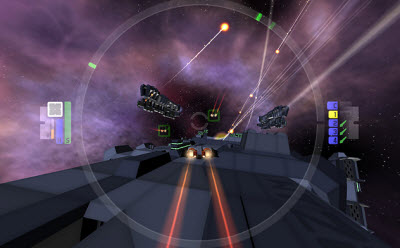 GamesBeat: I’m sure everyone knows you’ve grown fast in this sector, and that you’re very important now. But maybe they don’t know exactly how you make money, what your business actually is.
GamesBeat: I’m sure everyone knows you’ve grown fast in this sector, and that you’re very important now. But maybe they don’t know exactly how you make money, what your business actually is.
Helgason: It’s pretty old-fashioned. My father’s now over 80. He once said a few years ago, “You know, your company is quite old-fashioned. You make a product and you sell it to people who use it.” It’s a tool and the people who use the tool buy it. We sell it on a purchasing basis. That’s the bulk of the revenue.
GamesBeat: On a premium level?
Helgason: Yeah. EA and some of the big companies buy a lot of it, so they get some sort of enterprise deals. We’ve announced a few of those, but there are many others that aren’t big enough to talk about.
However, we’ve been thinking about how to broaden our support for the developer ecosystem. One thing we came up with a few years ago is this asset store, where developers can trade amongst each other. If somebody’s created a script to achieve a particular purpose, they can sell it for whatever dollars. Often they’re in the $0-$100 range. It ends up being a pretty big marketplace. We take a 30 percent cut, which covers the cost of running it. It’s profitable, but not wildly so.
One way to slice it is, on a run rate basis there are six million packages — assets, scripts, particle systems, animation clips – being downloaded from the store on a yearly basis. Many of them free, also many of them sold. Some of these things will take a professional between one and a few days to make. Some will take upwards of two weeks. If you just add up a day of saved work per downloaded asset, going by a $50,000 fully loaded global salary, which I think is quite useful as a metric, it’s very hard to get under a billion dollars of saved work for the industry. That’s pretty wild. That’s much more important than the revenue for us, which is just cost-plus at this point.
GamesBeat: Are you at some point going to talk about how much downloading is going on there, how many units of these things are coming from the asset store?
Helgason: Like I say, six million packages per year. That’s the current rate, like half a million packages per month. It’s growing every month, but that’s the run rate currently.
GamesBeat: That seems like it’s going to have some decent upside. It may be a more important business, at some point, than the rest of your business, selling licenses.
Helgason: Maybe? It’s not, at this point. It’s a low net margin business. When we sell a license of Unity Pro, we keep 90-something percent of that as our margin. When somebody sells a $100 package, we keep $30 from the store. It’s very different.
GamesBeat: And you have services now. You acquired Applifier, and I think somebody else, too?
Helgason: Yeah, Playnomics. It’s a business, but more important, we started the company asking the question, “How can we help developers of all sorts, from the biggest to the smallest, make great games?” Then we got that back and we realized that there are two questions that developers live and die by. The first is, “Can I make a great game?” There are lots of sub-questions about the right platform, the right features, performance, cost efficiency, production, all these things, and we worked hard on that for 12-ish years. But they also live and die by another big question, which is, “Once I create a great game, can I connect that game with an audience?”
There’s a lot of solutions out there. The app stores are great. If you get into the rankings it’s great. If you get editorialized by Apple or Google, that’s great. But there’s also answers to that question that aren’t as obvious. There are answers that we think benefit from being integrated into Unity, or that can benefit from our scale.
One is, we acquired an ad network, GameAds, which we’re working on making bigger now. It’s already quite big, but it’s growing fast. You sell traffic or buy traffic. We care, probably, as much about the sell side. Small developers with high-traffic apps that don’t monetize very well as the buy side, we’re driving traffic to their games.
There’s also Everyplay, which is a game replay sharing network. As you’re playing a game, when something great happens in the game, there’s a button where you can push a video up to YouTube or Facebook. It’s one of these things that performs very well for developers already, but we wanted to make it much bigger and better-integrated.
GamesBeat: This is a new sector for you guys to go into. Why did you decide to go into this layer of the business?
Helgason: It’s this question that we see many of our customers not just living by, but dying by. They have a hard time getting the right traffic to their games.
GamesBeat: There are, what, maybe 400 companies in this middleman space? They’re all trying to sell a different solution to the gamemakers who are wondering what the solution is for getting traffic and downloads. Why have Unity as one more company in the space?
Helgason: It’s fair to say that of the 400, we picked the one we were most passionate about in Everyplay. It’s a free service. It’s not really advertising. It’s not really a lot of these things. It’s a pure mechanism for players who are playing the game to share their experience. From that, games get additional traffic. It’s a beautiful thing. It’s well-coded by a small Finnish team. There’s a lot of brilliant people in Finland for whatever reason.
We felt this was a solution we could bring out to our customers that will help them. We already saw it, before we acquired them, driving traffic to cool games. Also games that are premium downloads, or DLC-based rather than in-app purchase-based, which we think is underserved. It’s something that needs more power in their ecosystem. It doesn’t invalidate the 399 other companies, of course.
GamesBeat: Do you see Unity as a consolidator in the space?
Helgason: Only in the sense that, something like Everyplay, it was a fragile, underfunded company. We were afraid that they would get bumped around. So, in that sense, by bringing it into a bigger ecosystem and giving it the boost that we could give them, yes, that helps. But we’re not a consolidator. We don’t think we should pick winners in every category.
GamesBeat: What is your approach to mobile?
Helgason: It’s been very simple. The tool already exists. We made it export to iOS and then export to Android and Windows Mobile and Blackberry. People could build for the platforms they cared about.
GamesBeat: This stuff used to be really hard to do, right?
Helgason: It depends. If you want to be not so generous, or more generous to the games industry, the games industry has always had tools for themselves. This industry possesses some of the smartest developers in the world. Big companies in particular could always figure this out. But here came a tool that was as good as the best of them and available to the rest of the people that didn’t have these teams, didn’t have the experience, or didn’t have the time and money to spend on building their own tech. That’s where we came from.
It turns out that it’s also cost-effective for some of the big companies with tech to buy our stuff, because it saves them costs and allows them to deploy their best engineers on actually building games, which is the real [difference-maker] these days.
GamesBeat: Is it at this point where it’s trivial matter for you to add another platform?
Helgason: I wouldn’t say it’s trivial. The cross-platform aspect of Unity—we talk about mobile platforms, but we support between 15 and 20 actual platforms, including the consoles and PC and web and WebGL now. It’s not trivial to do all this stuff at the same time. In fact, it’s kind of the opposite. We had to innovate a lot to make this possible.
GamesBeat: This is why you have 400 people.
Helgason: It’s definitely a big part of it. It’s not easy to do this.
GamesBeat: Your competitors, like Epic and Crytek, came from the top down, in high-end and console games. You’ve bubbled up from the bottom, in a way. Can you talk about that dynamic?
Helgason: It’s a good question. They came from a world where they had their own studios and primarily worked on their own games. Then they commercialized their engines. That just wasn’t our path. We built our own software, but we decided that the other path was more interesting to us.
It’s so different, how we think about the world. At some point we said, “We’re going to be cheaper,” and then we said, “We’re going to be cheap and free.” In 2009 the other guys went free as well, but they failed to get traction from that. They’re trying to revamp their offerings now, with subscription and the backend, and updated tools that are better than they used to be.
Bizarrely enough, it’s not showing up in our numbers at all. Nobody actually left, it seems. Our numbers are just as stable as they’ve always been. But it’s interesting to see the industry being more competitive now than it used to be.
GamesBeat: With their base price, they’re trying to undercut you.
Helgason: They actually went up in price, in a way. Now Unreal has a five percent backend, which arguably makes it the most expensive engine on the market. It doesn’t really matter. I won’t go into the math.
GamesBeat: What are you hoping for over time, in the next year or two years? What do you want Unity to be, and the ecosystem as well?
Helgason: I want Unity to be the same as it is, serving developers as well as we can with great tools and services. We want to focus on their success. That’s Unity. I don’t see us changing. What I want for the industry is a few things. I want more power to premium games and storytelling games, games that are more culturally relevant than the hardcore-est of hardcore freemium titles. Apple and Google support that to some level, and I think they’ll support it more.
We want to support it more with things like Everyplay, where instead of seeing an icon in an app store, you actually see a video of what the game offers. That gives a lot of power to people with compelling, deep experiences. Now, most games seem to get downloaded through an icon or a name, which is hard to put a value on. It’s part of why free games dominate so harshly.
Otherwise, we want to follow where the ecosystem takes us and support the needs of developers.
GamesBeat: Is there a way you think you can get into the heart of what people consider the traditional game industry, the home console business?
Helgason: We are there, in the sense that a lot of console games are being built with Unity now. We partnered with the big platforms. Unity’s free for Xbox One and Wii U. Sony’s sponsored licenses for PlayStation. A lot of titles are coming out from first parties. So we’re definitely there. Also some large PC franchises are using Unity.
GamesBeat: What about micro-consoles? Are you optimistic about that category?
Helgason: I want to be. I want to be optimistic about everything. The more opportunities there are for developers, the better. I guess there are questions about Ouya now. I haven’t followed the news too closely. There are lots of rumors.
It’s great if these devices have traction, because again, people clearly want to play games in a lot of places. It’s tough for micro-consoles to compete with mobile, though. This is just a device people have in their pocket. To do an additional purchase, I think, is a tough sell to everyone except the more hardcore audience, which is already buying these wildly more powerful consoles.
GamesBeat: Now that you’re in services, what do you think is going to happen to solve the problem that mobile game companies have with discovery and user acquisition?
Helgason: I don’t know. We’re going to help a little bit, and maybe a lot. We acquired Playnomics, which is a sort of—they do analytics, but the goal of it is CRM, managing your users. Predictive analytics and making decisions based on behavior about how you should deal with your players. We’re going to do everything we can to give great tools like that to developers.
Besides that, I think a lot of it is on the app store managers to elevate games that are really good. They already do a decent job of it. But not just the people who can buy their way through the rankings. All my intuition is screaming that this is going to happen, and then we’ll have a healthier industry in a year or two.
GamesBeat: What do you think the quality level will be like in a year or two for the best mobile games?
Helgason: It blows my mind every year. The quality, the polish goes up so dramatically. Just in our world, which is a sort of annex to the whole mobile industry—we have awards every year for the best games in our ecosystem. At some point I said, “Every game that was nominated this year would have won every award last year.”
That’s how I feel about the whole industry, or at least the mobile ecosystem. It’s going up at a staggering rate. The devices get more powerful. Developers get smarter. The ecosystem gets bigger so they can afford to invest more. The tools get better. People get great at making games for mobile. Three years ago, nobody had more than a couple of years’ experience in mobile. Now a lot of people have five-plus years. There are many sharply inclining lines layered on top of each other.
GamesBeat: Knowing what you guys know about the game business and gamemakers, what sort of visibility is most interesting to you, that you get from this? What’s the direction of the game industry right now? What kind of analytics information do you absorb that you can direct people with?
Helgason: It’s just in the biggest lines, in that—We see everything working. We see two-person teams building fantastic games and making enough money that they can pay the bills for several years, which enables them to build wonderful studios. We see every type of thing working, and of course also not working.
The possibilities are so wild. The industry, or at least the press, can be a bit myopically focused on one company making $1 billion. There’s a lot of people making $1 million to $5 million, which is incredible, if you’ve invested only a couple hundred thousand. We see that everywhere. The main thing is just the continuing explosion of opportunity. That’s the top line for us.
You may have heard me say this before, but if you go back 15 years, if you had a product you wanted to show the world of any kind, the biggest way to take that to the market would be prime time U.S. television. You might get noticed by 100 million people if you spent a lot of money. Now you can take a quality offering to a few app stores and marketplaces and reach more than 2 billion people. In five years that’ll be 4 billion people. It’s 40 times larger in the space in 20 years. It’s liquid. There’s no particular friction in it except the competition with others, which is significant. But we keep seeing amazing things get a lot of traction. To be part of the industry in this time is mind-blowing.
GamesBeat: It’s interesting to see user-generated content grow like crazy. I wonder, is there an opportunity for you guys in that space? Right now, you’re mainly helping professional developers. There are also players who want to create for these games.
Helgason: There some really amazing games that solicit user-generated content. Stair Dismount had that on Steam. We’ve not seen a lot of user-generated content on mobile, because the tools to create are still kind of wonky there. But people will figure it out. With the traction user-generated content has on other platforms, it’s impossible that nobody’s going to be successful with that in the next few years.
Our main job sometimes, especially with development features, is just to get out of the way and make it possible for developers to do. It’s possible and it’s easy, so we’re just not in the way. It’s going to be exciting when that happens.
GamesBeat: If something’s taking off in the asset store, maybe all of the other game developers should take note. There’s this thing that everyone seems to be using.
Helgason: Oh, I think everyone who uses Unity relies heavily on the store. The cost savings from using it are just mind-blowing. The people who are selling, they’re doing really well. Several hundred are having a significant income from it. Several dozen might be between making a full living and getting rich.
Question: You mentioned that you wanted to be optimistic about micro-consoles. Of course, there’s a lot of discussion from you and others about the growing power of mobile devices. We’re bullish on connecting phones to big screens through wireless HD and other technologies. I’d like to know your thoughts and plans for supporting tools as far as doing things simultaneously on the small screen and the big screen.
Helgason: We already support that with mirroring, which is separate. On iOS you can also, for example, have different views. With Samsung we’re working on their multiscreen project, to make it really easy for their ecosystem. Over time we just want to make sure that it’s easy everywhere.
The reason we haven’t gone all in from the very beginning of that trend is just because we haven’t seen a lot of need for it. The pull hasn’t been there. You have latency issues and controller issues and so on, which makes it hard—Doing something with your touch device while something plays on the big screen is kind of hard. But no, no good answer, other than we think it’s a very viable use case and we want to support it. People have done it and it does work in many cases, for a lot of different situations.
Question: The rumor a while back was that AutoDesk was trying to acquire you guys. Thanks for not selling, if that was at all possible.
Helgason: If I had a dollar for every rumor about acquisition, I wouldn’t be rich, but I could buy myself a really nice meal.
Question: I wonder if you could set our minds at ease, though. To a lot of developers, Unity is almost priceless, and we want you guys to stay independent. Maybe you could talk about your vision for the next 12 to 24 months, where you see Unity, and if there’s any exit on the horizon?
Helgason: No, I can say with perfect candor that there’s no such discussion going on, no negotiation, and nobody in particular is approaching us right now. There have been approaches in the past. Good technology companies get approaches. But we’re very focused on being able to support the whole ecosystem and be a kind of Switzerland between all the platforms – hardware devices, operating systems, publishers and down that line. We really believe that Unity is best if we can support everyone. That’s been our long-term plan and tradition.
That’s also how we structured the company. We raised venture money, but we put all the money in the bank. We’re very conservative about how we run the business. We know it’s more important for developers that we’re there than that we have a particular style of success or whatever. We’ve now been on the market for nine years. The goal is to keep Unity on the market for another 10, 20, however many years we can keep at it.
GamesBeat: What else would you say are some decision that you have to make to keep Unity useful for indies?
Helgason: One of them is just letting our developers – the people who are in the company, creating the product — make a lot of decisions on their own. They’re recruited largely from the game industry, and from all kinds of companies, including small studios. Their intuitions as far as what developers need are really good. That’s one way we do it.
Another is, we partner with a lot of big companies, but we partner very carefully and selectively. We don’t do exclusives. We don’t overcommit ourselves to one particular direction or form factor or operating system and so on.
Question: What are your plans for supporting HTML 5 as a run-time?
Helgason: We started working on that quite a while ago. We announced it and showed it at GDC a couple of months ago, a Unity exporter for HTML 5 and WebGL. It’s running really well. It’s not perfect, but it’s going to be out in what we call a preview with our Unity 5, which is the next big release. It doesn’t have a date yet, but it’s getting really close. It definitely exists and it’s surprisingly awesome.
GamesBeat: Are you optimistic that we could get to universal cool 3D browser games?
Helgason: Yes, if you count “universal” as only new browsers. A couple of browsers are big question marks as far as whether they’ll support WebGL at all. For these, we still have our browser plugin, so you can create the same content across browsers that support WebGL or not. But give it a couple more years. I wouldn’t be surprised if every major browser supported WebGL.
GamesBeat: And then we don’t need consoles anymore?
Helgason: Ah, it’s not that simple. HTML 5 is very fast. JavaScript in HTML 5 is really fast. But it’s still a thick layer between the CPU and the code. So no, I think it’s only part of the use case. We need native for at least quite a while still. More than a couple of years.
VentureBeat's mission is to be a digital town square for technical decision-makers to gain knowledge about transformative enterprise technology and transact. Learn More

